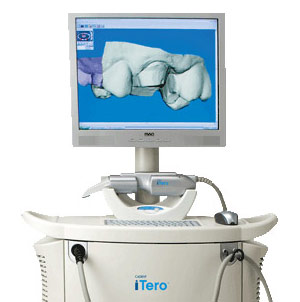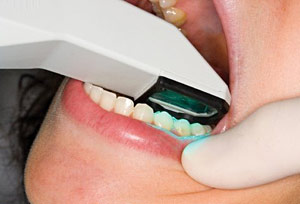 For years, whenever you needed a dental crown (cap), your dentist had to make molds of your teeth which required taking an impression of your teeth. A tray filled with a goopy, putty-like material was used so that a three-dimensional model of the prepared tooth could be created. Using this mold, along with a dental lab, we could custom-craft the new crown.
For years, whenever you needed a dental crown (cap), your dentist had to make molds of your teeth which required taking an impression of your teeth. A tray filled with a goopy, putty-like material was used so that a three-dimensional model of the prepared tooth could be created. Using this mold, along with a dental lab, we could custom-craft the new crown.
However, as we journey further into the technology-driven 21st century, this former methodology is being replaced with virtual models — made using small, handheld “wands” that employ a digital camera and some “magic” reflective dust.
Here's how it works
The first phase of restoration, preparing the tooth surface, remains virtually the same. We must remove any dental decay and shape the remaining tooth for a crown or filling to be fitted properly. This will allow us to restore a tooth to its original shape, look, and function. Next, we lightly dust the area with a reflective material (no goopy impression material) so that we can record multiple images of your tooth's surface with our small scanning wand. Later, the computer component is connected to the scanning wand and will combine these images into a computer-generated 3D image.
 This remarkable tool uses blue wavelength light so that we can precisely capture the unique nooks and crannies of your tooth's surface to make a highly accurate 3D digital model. It enables us to instantaneously examine a tooth and your bite. Another advantage of this process is that we can immediately identify any additional prep work required for new crowns, veneers and fillings; implement those changes; and rescan the tooth to create a new series of images and 3D model.
This remarkable tool uses blue wavelength light so that we can precisely capture the unique nooks and crannies of your tooth's surface to make a highly accurate 3D digital model. It enables us to instantaneously examine a tooth and your bite. Another advantage of this process is that we can immediately identify any additional prep work required for new crowns, veneers and fillings; implement those changes; and rescan the tooth to create a new series of images and 3D model.
Once we are pleased with our images and prep work, we simply then send your images to the lab for fabrication. This technique will allow us to create a crown or a filling that can often be completed during a single office visit.
How this technology benefits you
- Finally, you can say goodbye to the goop, gagging, discomfort, and anxiety you've experienced in the past with traditional dental impression materials!
- It gives us the immediate ability to assess whether or not we've adequately prepared your tooth for restoration.
- This technology is ideal for fabricating restorations such as new crowns, veneers and fillings for teeth — often possible in one office visit.
- It takes less time than traditional dental impressions.